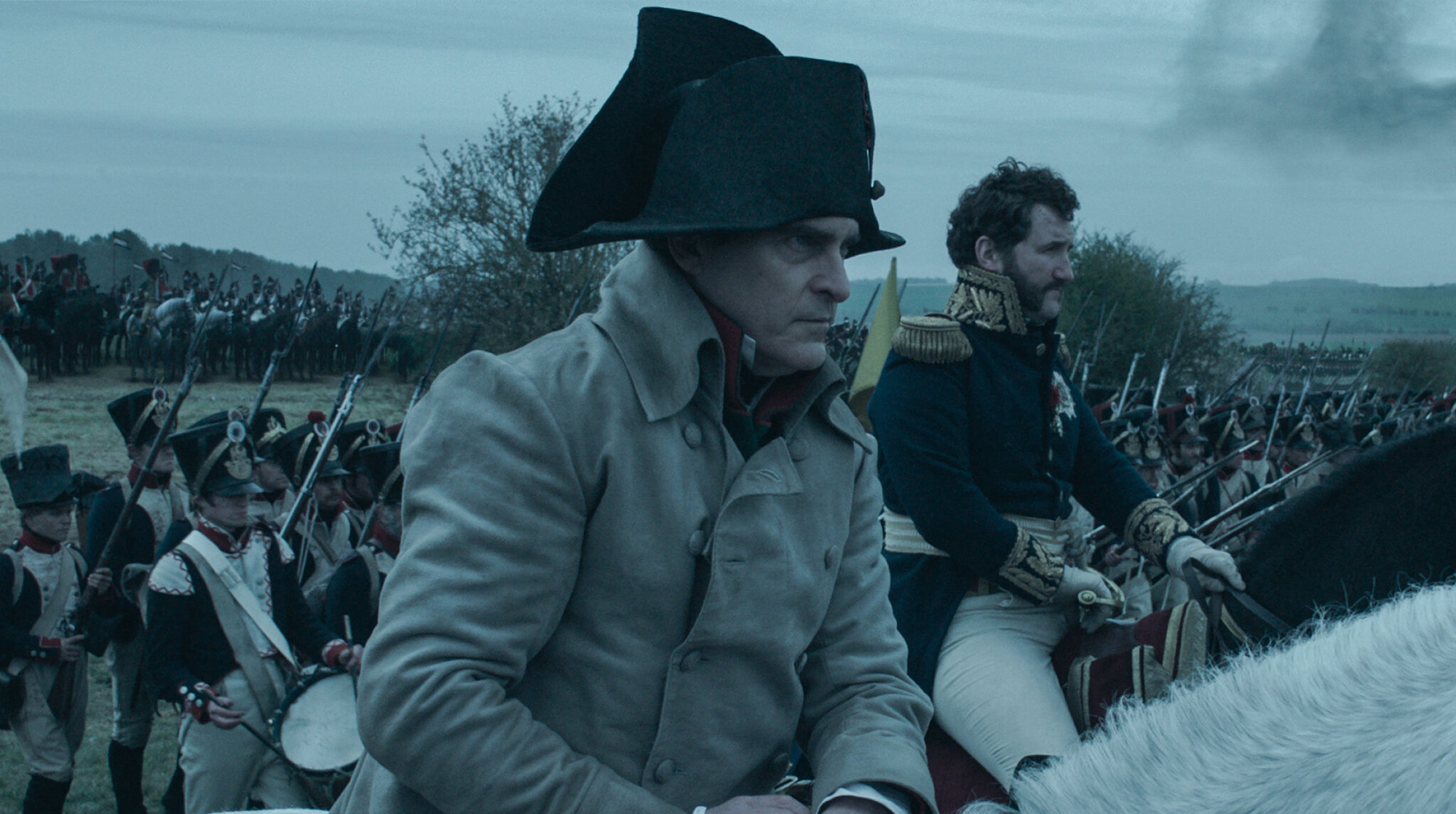
This article contains spoilers for Ridley Scott’s Napoleon.
Even in the first trailer, it is an immensely chilly spectacle. On a frozen field in central Europe, Napoleon Bonaparte, the supreme general and Emperor of France, holds the high ground. From a well-fortified and concealed position among many trees, his army has laid a perfect trap for the forces of the Austrian and Russian empires. And from their embankment, they watch coolly as the enemy blunders right into a massacre.
In the ensuing chaos, thousands of men, horses, and rolling cannons attempt to flee the thunderous crack of Napoleon’s artillery, but to no avail. Spotting a weakness as the Russian army desperately tries to retreat across a frosted lake, Napoleon has his cannons aim directly at the ice. Man and beast alike cry in agony as the white mirror beneath their feet cracks, and a frigid, horrifying death rushes up to swallow them whole in subzero waters.
Under Ridley Scott’s direction, the full breadth of this horror is felt by the film and Joaquin Phoenix’s steely gaze. We as an audience are asked to bear witness as a single Russian officer, carrying his nation’s flag, desperately attempts to outrace the collapsing ice on his horse, the two seemingly being the last living souls who oppose Napoleon’s dominance. As that flag waves meekly in a sunless sky, Napoleon’s final cannon finds its target, and horse and rider both go crashing down into the darkness that awaits. They’ll never be seen again as the camera follows their descent into the abyss, the ice above becoming a vast coffin’s lid.
It’s absolutely terrifying. Here is the grisly punctuation mark on Napoleon’s greatest victory: a catastrophic slaughter of his greatest continental opponents, and a declaration for good and all (or at least the next handful of years) that Napoleon alone is Master of Europe! This is how Napoleon’s armies chronicled the devastating final moments for tens of thousands of Russians (if not more) who met the French general outside of a little town called Austerlitz on Dec. 2, 1805, and it is how Napoleon’s last reigning triumph is remembered still—as evidenced by no less than it being a centerpiece sequence in a Ridley Scott movie.
The aforementioned trailer even ends with Napoleon’s voiceover smirking, “I’m the first to admit when I make a mistake. I simply never do.” For those who know anything about the history of the Napoleonic Wars, the line is deeply ironic considering the French emperor’s later exploits in Russia or on the fields of Waterloo. However, whether intentionally or not, how the sequence itself is dramatized in Napoleon could be a mistake… at least according to modern scholarship and historians.
The Battle of Austerlitz and Napoleon Triumphant
Scott’s Napoleon is right to bask in what was one of the most impressive showcases of Napoleon’s tactical brilliance. For on this day, the French ruler soundly defeated the Austrians and Russians at the same time, despite the other empires having the greater numbers. Often romanticized in the 19th century as “The Battle of the Three Emperors,” Austerlitz was a climax of sorts to the most concerted effort yet by France’s enemies to curtail Napoleon’s ambitions and ever expanding tendrils.
The culmination of what is also known as The War of the Third Coalition, the Battle of Austerlitz occurred after the Allied forces of Great Britain, the Austrian Empire, the Russian Empire, Naples, Sicily, and Sweden rallied to war following, among other things, Napoleon’s encroachments into the Italian and Germanic lands, and his ordering the execution of Duke of Enghien in 1804. As a consequence, battles were fought that determined the fate of Europe for the next century (although not necessarily on land, but more on that later…).
To narrow this to just the sequence in the film, Napoleon is correct to depict the Battle of Austerlitz, which occurred in what is the modern day Czech Republic, as a brutally effective trap sprung by the French emperor against his enemies. Prior to the battle, Napoleon attempted to cultivate a false sense of security in the far larger Austro-Russian army. This was achieved by seeding false information that Napoleon’s men were starving and demoralized with the coming of winter; he also seemingly weakened his position on the land near the town of Austerlitz, known as Pratzen Heights, thereby suggesting the French were abandoning their positions. He even resorted to play-acting for the Russian envoy Prince Peter Petrovich Dolgorukov the month before the battle. Reportedly during a meeting with the Russian princeling, Napoleon affected nervous facial tics which were intended to suggest that the French emperor was terrified of his Russian opponents.
On the morning of Dec. 2, his enemies, urged on by an overconfident and tactical novice in Tsar Alexander I, took the bait and descended on what they assumed to be abandoned positions along Pratzen Heights. In actuality, Napoleon had divided his forces among a handful of generals in concealed locations around the trap, and the French cut the Austro-Russian army to pieces.
While the War of the Third Coalition limped on into 1806, it was effectively over when a humiliated Austria signed a peace treaty with France on Dec. 26—after Napoleon actually really did mock the Austrian general by offering him French wine following the slaughter at Austerlitz, which left anywhere between 16,000 and 36,000 Allied soldiers dead. By comparison the French only lost 9,000 soldiers.
So What’s the Story with the Ice?
Napoleon’s victory over the Austro-Russian forces that December was total. And the way it was canonized by the likes of French general Adolphe Marbot was even more impressive. Marbot provided one of the earliest, and most influential, accounts of Russian forces fleeing in a panic across a series of frozen ponds only to be sent to a watery grave. “Thousands of Russians, with their horses, guns, and wagons, slowly settled down into the depths,” Marbot said.
So convincing were these accounts, that it became the accepted wisdom of what happened that day when the history was written by the final victors of the Napoleonic Wars: the British and their assorted allies and sympathetic associates. Consider American historian John Stevens Cabot Abbott’s influential multi-volume biography on Bonaparte, The History of Napoleon Bonaparte, first published between 1855 and 1856. In this account, Abbott wrote:
“A division of the ruined army, consisting of many thousand men and horse, sought to escape by crossing, with artillery and cavalry, a frozen lake which adjoined their line of march. The surface began to yield beneath the enormous load, when a few balls and shells from the French batteries broke the ice, and the whole mass was plunged into the freezing waves. A fearful cry, resounding above the roar of battle, ascended from the lake, as the frantic waves closed silently over them all, and those unhappy victims were sepulchered forever.”
Even Tsar Alexander I allegedly later confessed to other aristocrats in Vienna in 1814 that he watched helplessly as 20,000 Russians died beneath the frozen ponds. Twenty thousand!
For nearly a century, this became the accepted version of events until historians a century later began to wonder… if 20,000 or more Russians and their horses fell beneath frozen lakes… wouldn’t they have left behind a spectacularly garish spectacle when the lakes thawed the following spring?
Hence why there was so much interest when Oxford historian and Napoleonic skeptic Reginald L. Poole rejected this story as nothing more than French propaganda in an influential article published in The English Historical Review in 1902. In Poole’s research, he discovered that accounts of the weather in the local Oberamtmann newspaper in early December 1805 reported the ice was relatively thin, so it was unlikely to support a full army in retreat. Poole also discovered that on Napoleon’s orders, the French army drained the lakes within a few days of the battles, whereupon the recorded discoveries found between 28 and 30 cannons, the corpses of 150 horses, and only two or three human bodies. Furthermore, in the century that passed, no more human remains, remnants of cannon fire, or any other weapons of war were ever discovered around the lakes in question.
Poole persuasively argued that if the ice did break, it only occurred as soldiers were fleeing around the edges of the frozen bodies of water, likely recognizing they were too thin to cross over, and when the ice broke, the few who were on the outskirts were mostly able to escape unharmed (unlike their horses).
In the century since this article, historians have continued to quibble over the number, with many now debating that the total number of soldiers who died in the water could have been anywhere between 38 men to a few hundred. Some even erroneously still insist it might’ve been a few thousand—but not 20,000. So why exaggerate the spectacular slaughter of Russians?
Because if you saw the movie Napoleon, you know it is a staggeringly dramatic and visceral way to smite your enemies! And in the winter of 1805/6, Napoleon needed to remind the French citizens at home of his power—and possibly to raise their spirits at the thoughts of Russian soldiers crying as the ice slams over their heads.
While the Battle of Austerlitz was decisive in cementing Napoleon’s status as the most powerful man in continental Europe, it came only after an equally decisive—and ultimately longer lasting—defeat at sea. On Oct. 21, 1805, the British Royal Navy masterfully and completely demolished the combined fleets of the French and Spanish navies at the Battle of Trafalgar. As a consequence, Great Britain cemented itself as the unrivaled master of the seas around Europe. As Napoleon himself is attributed to have said, the power of Europe was divided between the whale (Britain) and the elephant (France).
The War of the Third Coalition was over, but the conflict between these two great monsters was destined to continue. So any morale-boosting story that winter of a vanquished enemy dying in ignominy was a boon to French citizens, and even a decade later, it may have proven convenient to a Russian tsar who needed to make excuses for why the Russians so quickly abandoned the Austrians and British to an enemy they were still fighting in 1814.
Or, maybe even a Russian tsar might’ve agreed, whether it’s fact or fiction, the version where thousands went into the ice is pretty damn cinematic. Ridley Scott clearly does.
Napoleon is in theaters now and will make its global streaming premiere on Apple TV+ down the road.
The post The Real History of Napoleon’s Greatest Victory Didn’t Happen Like in the Movie appeared first on Den of Geek.





